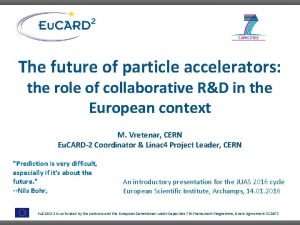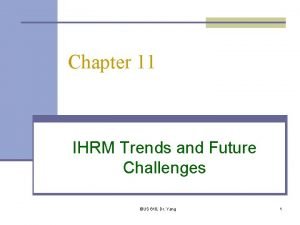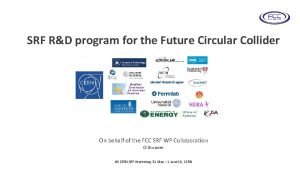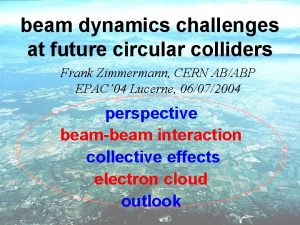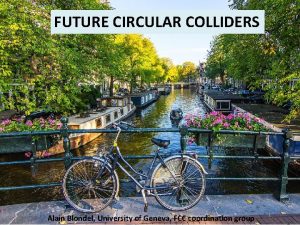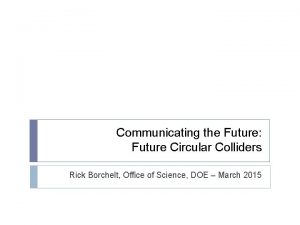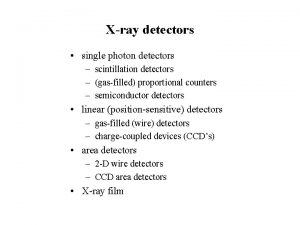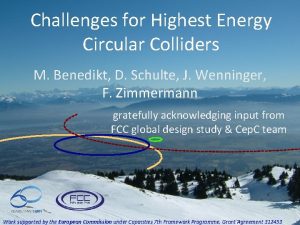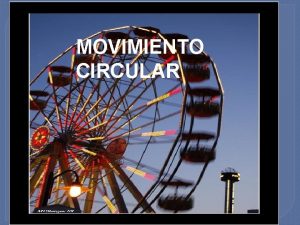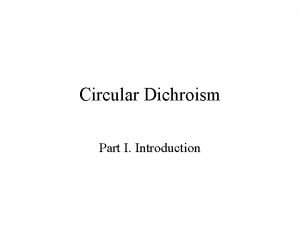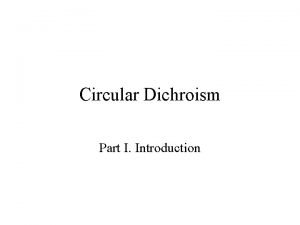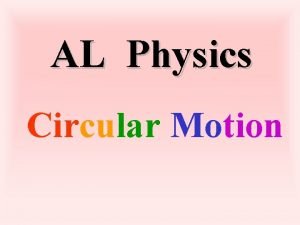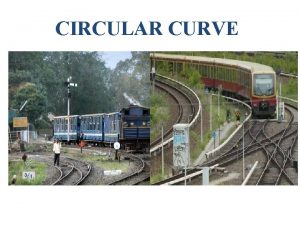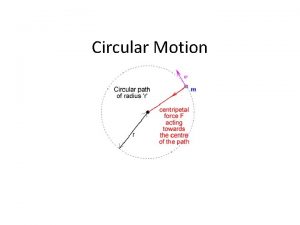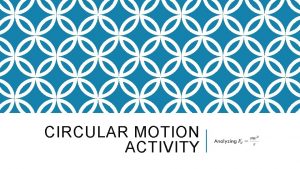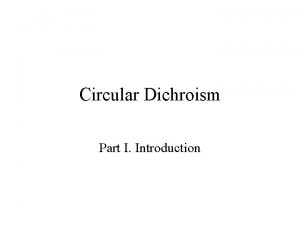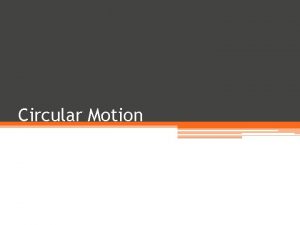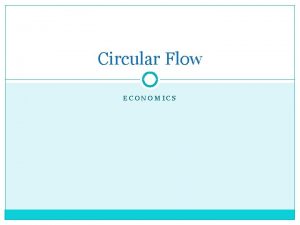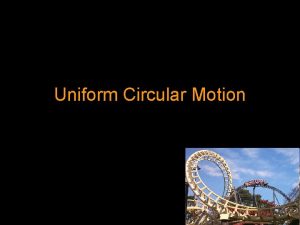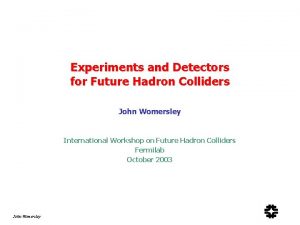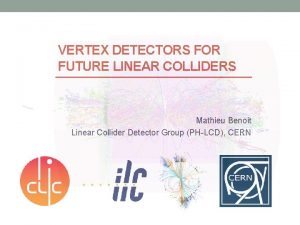Challenges for Particle Detectors at Future Circular Colliders

















































- Slides: 49

Challenges for Particle Detectors at Future Circular Colliders RD 50 collaboration meeting 2 December 2015 W. Riegler, CERN Material on accelerators from M. Benedikt W. Riegler, CERN 1

Abstract Future Circular Collider (FCC) is an integral conceptual design study for post-LHC particle accelerator options in a global context. It is exploring the potential of hadron and lepton circular colliders, performing an in-depth analysis of infrastructure and operation concepts and considering the technology research and development programs that would be required to build a future circular collider. A conceptual design report will be delivered before the end of 2018 , in time for the next update of the European Strategy for Particle Physics. This talk will give an overview of the FCC studies and present specific aspects of experiments and detectors at the 100 Te. V hadron collider that is a key part of this study.

Strategic Motivation • European Strategy for Particle Physics 2013: “…to propose an ambitious post-LHC accelerator project…. . , CERN should undertake design studies for accelerator projects in a global context, …with emphasis on proton-proton and electron-positron high-energy frontier machines. . …” • ICFA statement 2014: ”…. ICFA supports studies of energy frontier circular colliders and encourages global coordination. …. ” • US P 5 recommendation 2014: ”…. A very high-energy proton-proton collider is the most powerful tool for direct discovery of new particles and interactions under any scenario of physics results that can be acquired in the P 5 time window…. ” W. Riegler, CERN

Future Circular Collider Study International FCC collaboration (CERN as host lab) to study: • pp-collider (FCC-hh) main emphasis, defining infrastructure requirements ~16 T 100 Te. V pp in 100 km • 80 -100 km infrastructure in Geneva area • e+e- collider (FCC-ee) as potential intermediate step • p-e (FCC-he) option • HE-LHC with FCC-hh technology W. Riegler, CERN

FCC motivation: pushing the energy frontier The name of the game of a hadron collider is energy reach E α Bdipole x Rbending Cf. LHC: factor ~4 in radius, factor ~2 in field O(10) in Ecms W. Riegler, CERN 5

CERN Circular Colliders and FCC 1980 1985 1990 Constr. Design 1995 2000 Physics Proto 2005 2010 2015 2020 2025 2030 2035 LEP Construction Design LHC Physics Construction Physics HL-LHC 20 years FCC Design Proto Construction Physics FCC Conceptual Design Report by end 2018 for the European strategy update W. Riegler, CERN

FCC Scope: Accelerator and Infrastructure FCC-hh: 100 Te. V pp collider as long-term goal defines infrastructure needs FCC-ee: e+e- collider, potential intermediate step FCC-he: integration aspects of pe collisions Push key technologies in dedicated R&D programmes e. g. 16 Tesla magnets for 100 Te. V pp in 100 km SRF technologies and RF power sources Tunnel infrastructure in Geneva area, linked to CERN accelerator complex Site-specific, requested by European strategy W. Riegler, CERN

Scope: Physics & Experiments Elaborate and document - Physics opportunities - Discovery potentials Experiment concepts for hh, ee and he Machine Detector Interface studies Concepts for worldwide data services Overall cost model Cost scenarios for collider options Including infrastructure and injectors Implementation and governance models W. Riegler, CERN

LEP – highest energy e+e- collider so far circumference 27 km in operation from 1989 to 2000 maximum c. m. energy 209 Ge. V maximum synchrotron radiation power 23 MW W. Riegler, CERN 9

FCC-ee physics areas W. Riegler, CERN 10

Site investigations • 90 – 100 km fits geological situation well • LHC suitable as potential injector W. Riegler, CERN

FCC-hh preliminary layout 100 km layout for FCC-hh (different sizes under investigation) Two high-luminosity experiments (A and G) Two other experiments (F and H) grouped with main experiment in G Two collimation lines Two injection and two extraction lines W. Riegler, CERN 12

IP 30 mrad FCC-ee layout “Middle straight” ∼ 1570 m ∼ 12 m FCC-hh 9 m 0. 8 m “ 90/270 straight” ∼ 4. 7 km Based on, and compatible with, FCC-hh layout (in green) Common RF As the separation of 3(4) rings is within 15 m, one wide tunnel may be possible around the IR. IP W. Riegler, CERN 13

Key Technology R&D - HFM Nb 3 Sn 16 T Conductor R&D Magnet Design • Increase critical current density • Obtain high quantities at required quality • Material Processing • Reduce cost W. Riegler, CERN • Develop 16 T short models • Field quality and aperture • Optimum coil geometry • Manufacturing aspects • Cost optimisation 14

Key Technology R&D - RF Beyond Nb Efficiency Superconducting RF Power Conversion Evaluate new fabrication techniques • Study novel superconducting materials • Improve thin film / coating techniques • Optimise operation temperature to improve energy efficiency • Future Circular Colliders Michael Benedikt 10/7/2020 Push klystron efficiency beyond 75% • Increase power range efficiency of solid-state amplifiers • Assess power reach of IOTs • Document reference 15

Synchrotron radiation/beam screen High synchrotron radiation load (SR) of protons @ 50 Te. V: ~30 W/m/beam @16 T (LHC <0. 2 W/m) 5 MW total in arcs New type of chamber absorption of synchrotron radiation - avoids photo-electrons, helps vacuum - LHC beam screen Photon distribution Heat transport W. Riegler, CERN 16

Euro. Cir. Col EU Horizon 2020 Grant EC contributes with funding to FCC-hh study • Core aspects of hadron collider design: arc & IR optics design, 16 T magnet program, cryogenic beam vacuum system • Recognition of FCC Study by European Commission. W. Riegler, CERN

FCC International Collaboration Status • • 61 institutes 23 countries + EC Status: 14 September 2015 W. Riegler, CERN

Baseline Parameters for the Hadron Machine The present working hypothesis is: - peak luminosity baseline: 5 x 1034 - peak luminosity ultimate: ≤ 30 x 1034 - integrated luminosity baseline ~250 fb-1 (average per year) - integrated luminosity ultimate ~1000 fb-1 (average per year) An operation scenario with: - 10 years baseline, leading to 2. 5 ab-1 - 15 years ultimate, leading to 15 ab-1 would result in a total of O(20) ab-1 over 25 years of operation. 19

FCC Hadron Detector Concepts

Physics at the Lσ Limit C. Helsens, M. Mangano 3 ab-1 Muon momentum resolution O(15%) at 10 Te. V. Constant term dominates, 1 -2% goal full shower containment is mandatory ! Do not compromise on 12 lambda !

WW scattering by VBF Mechanism Is H playing it’s role ? Unitarity at 1 Te. V ? Are there high mass resonances WW, ZZ, HH, … VBF jets between η~2 and η~6 need to be well measured and separated from pile-up Muons (and electrons) around ~1 Te. V p. T need to be triggered, identified, precisely measured

Higgs Measurements H 4 l acceptance vs η coverage (l p T cuts applied) H. Gray, C. Helsens 30 -50% acceptance loss for H 4 l at 100 Te. V wrt 14 Te. V if tracking and precision EM calorimetry limited to |η|<2. 5 (as ATLAS and CMS) can be recovered by extending to |η|~ 4 “Heavy” final states require high √s, e. g. : HH production (including measurements of self-couplings λ) tt. H (note: tt. H ttμμ, tt. ZZ “rare” and particularly clean) g. HHH~ v

More Exotic

Physics at a 100 Te. V Hadron Collider Exploration + Higgs as a tool for discovery Numerous physics opportunities with a large number of possible measurements. How to specify detectors for such a machine ? ATLAS and CMS are general purpose detectors that were benchmarked with the ‘hypothetical’ Higgs in different mass regions with tracking up to η=2. 5. The Higgs is also key benchmark for the FCC detectors, with highly forward boosted features (100 Te. V, 125 Ge. V Higgs) FCC detectors must be ‘general’ purpose detectors with very large η acceptance and extreme granularity.

Approximate Overall Needs Tracking: Momentum resolution ≈15% at pt=10 Te. V Precision tracking (momentum spectroscopy) and Ecal up to η=4 Tracking and calorimetry for jets up to η=6. 12 λin calorimetry, 1 -2% constant term. Calorimeter granularity of 0. 05 x 0. 05 or 0. 025 x 0. 025 to mitigate pileup and measure jet substructure and boosted objects. B-tagging, timing for pileup rejection etc. …

ATLAS, CMS, ALICE, LHCb

Tracking LHCb η = 2 - 5 … all with impressive performance … Tracking CMS tracking η -2. 5, 2. 5 h=1. 0 . 5 h=1 h=3

FCC Magnet System Concepts H. Ten Kate et al. Inclusion of Dipoles in the Forward region for momentum measurement over a large eta range. Huge mass, Iron very expensive Shielding Solenoid, very large system The ATLAS ‘standalone’ Muon Toroid was motivated by things like: • worries that trackers might not work at LHC rate At this moment we are using this magnet system as a baseline 07/10/2020 • Space for excellent HCAL, good jet calorimetry • Independent magnet system 29

CMS • • • LHC L*=23 m, TAS shielding inside the cavern Tracker r=1. 2 m in B=3. 8 T Compact Crystal ECAL, ‘short’ HCAL of and 5. 82 λint, cut at η = 3 to move FCAL away. Iron Yoke to return Flux, instrumented with muon chambers. CMS muons are relying on a properly working tracker. Muon Hcal Emcal Tracker Coil 07/10/2020 Tracker Emcal Hcal Muon Coil TAS Triplet 30

Twin Solenoid 7 x. BL 2 scaling • • • FCC L*=40 m, hide inside tunnel Solenoid and shielding solenoid with B=6 T in Tracker and B=3 T in Muon System Tracker r=2. 5 m, L=16 m, tracker resolution same as CMS detector ECAL+HCAL = 2. 4 m = 12 λint Momentum resolution gets marginal at η>3. 07/10/2020 Tracker Emcal Hcal Muon Coil TAS Triplet 31

Twin Solenoid 7 x. BL 2 scaling+Forward Dipole • Opening at η = 2. 5 • Adding a forward Dipole for momentum spectroscopy. • Moving forward calorimeters to larger distance decreasing the particle densities and overlaps. • Allows separate instrumentation and upgrade of forward detectors • Integration and maintenance is a challenge 07/10/2020 Tracker Emcal Hcal Muon Coil TAS Triplet 32

CMS scaled detector with very long extreme resolution tracker • • • Maximum coil producing 6 T with affordable iron yoke (r=4 m) Tracker radius 1 m, resolution has to be improved factor 6 (15 layers, 3 um resolution) 8 m long tracker gives large η acceptance. 2. 8 m available for EMCAL+HCAL e. g. very compact W/Si particle flow calorimeters Very high granularity forward calorimeters needed Muon system a’la CMS ‘extreme’ technology challenge. 07/10/2020 33

CMS scaled detector, very forward calorimetry move out • Forward calorimetry moved to large distance from η = 3. 5 for reduced occupancy and radiation load 07/10/2020 34

CMS & ATLAS Twin Solenoid + Dipole Popular at Present CMS+ 07/10/2020 35

Key Point and Strategy If the FCC hadron machine with 16 T magnets, 5 MW synchrotron radiation and a 100 km tunnel can be realized, there is no doubt that a detector, that makes full use of the physics potential, can be built. Much of detector technology is driven by silicon technology and computing power i. e. we can count on significant improvements. Since the maximum energy and delivered luminosity are the key goals for the FCC-hh machine, the detector efforts should put minimal constraints at the machine efforts. 14/02/2014 W. Riegler, CERN

What do MB events at 100 Te. V look like 14 Te. V 100 Te. V: Inelastic crossection 14 100 Te. V changes from 80 108 mb. Multiplicity 14 100 Te. V changes from 5. 4 8 charged particles per rapidity unit. Average p. T of charged particles 14 100 Te. V 0. 6 0. 8 Ge. V/c, i. e. bending radius in 4 T magnetic field is 50 67 cm. Transverse energy increase by about a factor of 2. The Min. Bias events at FCC are quite similar to the Min. Bias events at LHC. 14/02/2014 W. Riegler, CERN

Very Rough Estimate for Silicon Detectors Estimate for radiation load of first Pixel Layer at r=3. 7 cm: HL-LHC 3 ab-1 1 Me. Vneq Fluence = 1. 5 x 1016 cm-2 Dose = 5 MGy FCC 3 ab-1 1 Me. Vneq Fluence = 3 x 1016 cm-2 Dose = 10 MGy FCC 30 ab-1 1 Me. Vneq Fluence = 3 x 1017 cm-2 Dose = 100 MGy Estimate for radiation load of first Pixel Layer at r=2. 5 cm: FCC 30 ab-1 1 Me. Vneq Fluence = 7 x 1017 cm-2 Dose = 220 MGy With safety factors we go into the 1018/cm 2 and GGy range !

07/10/2020 39

Prospects for ‚Microelectronics‘ Data Storage Transistors/mm 2 Bandwidth ADC p. J/conversion All these figures showed doubling times of < 2 years up to now ! Some scalings will stop, but different tricks might come in. May dream about a factor 210 = 1024 from 2014 – 2034 (of course extremely optimistic) This would allow major detector improvements !

LHCb & ALICE in 2018 40 MHz 4 TByte/s into PC farm for HLT selection. 50 k. Hz 40 MHz Reconstruction + Compression 5 -40 MHz 20 k. Hz (0. 1 MB/event) 50 k. Hz (1. 5 MB/event) Storage 2 GB/s 1 TByte/s into PC farm for data compression. All events to disc. PEAK OUTPUT 75 GB/s

ATLAS & CMS in 2018 40 MHz Level 1 5 TByte/s into PC farm for HLT selection. 0. 5 -1 MHz Would be 200 TByte/s without Level 1 HLT 5 -10 k. Hz (2 MB/event) Storage 10 -20 GB/s 10 k. Hz (4 MB/event) PEAK OUTPUT 40 GB/s

Hardware Trigger ? CMS HL-LHC results in 200 TByte/s into the online system for a triggerless readout. For 2022 this is considered too difficult. Assuming that the total track rate for 100 Te. V pp collisions (Phase I) is only a factor 2 larger, there is very little doubt that by 2035 and FCC-hh detector can be read out in a triggerless fashion. In 2035 maybe no hardware trigger necessary ! All data to the online system, synchronous or asynchronous, where a sophisticated selection and compression can be done. !! N. b. the techniques to get the data out of the detector with a small amount of material is a key question to be solved !! Even if one would afford to read all data to HLT for Phase. II, the amount of copper lines to get all the signals out of the silicon detector would destroy the tracker performance. 14/02/2014 W. Riegler, CERN

Moore‘s Law http: //www. livescience. com/23074 -future-computers. html “If the doubling of computing power every two years continues to hold, then by 2030 whatever technology we're using will be sufficiently small that we can fit all the computing power that's in a human brain into a physical volume the size of a brain”, explained Peter Denning, distinguished professor of computer science at the Naval Postgraduate School and an expert on innovation in computing. "Futurists believe that's what you need for artificial intelligence. At that point, the computer starts thinking for itself. “ Computers will anyway by themselves figure out what to do with the data by 2035. Magnet systems and shielding will be rather conventional and can be worked out to some detail now. For detector technology and computing power we are allowed to dream a bit. 14/02/2014 W. Riegler, CERN

14/02/2014 W. Riegler, FCC kickoff

ALICE 2018 upgrade, 20 x 20 um monolithic pixels CERN-LHCC-2013 -024 14/02/2014 W. Riegler, FCC kickoff

Technical design report for the upgrade of the ALICE inner tracking system CERN-LHCC-2013 -024 Standard processing, no bump bonding (>>50% of Pixel detector cost). Allows implementation of complex processing electronics inside the entire pixel area. Revolution !

Pixel Revolution Hybrid Monolythic Dramatic decrease in cost. Very low power consumption, possibly <100 m. W/cm 2 i. e. simple water cooling Ultra low material budget <0. 5% for inner layers, <1% for outer layers. Question of speed and radiation hardness: At present, integration time of 4μs (noise, electron diffusion) radiation resistance up to few 1013 neq. Technical design report for the upgrade of the ALICE inner tracking system CERN-LHCC-2013 -024 Development (next 20 years) towards larger (full) depletion will improve speed and radiation hardness significantly. Also – in case one has a full pixel tracker one can use 1 or 2 layers with ‚fast‘ pixels to do the BCID (25 ns or even 5 ns) and then match the other hits. With a full pixel tracker of 20 x 20 um pixels one can pile up a fair amount of events before occupancy gets to large !!! 14/02/2014 W. Riegler, FCC kickoff

Conclusions Studies of accelerators and detectors for the post-LHC energy frontier are ongoing. A conceptual design report is planned for 2018. Basic concepts for detectors at these future colliders are being worked on. Silicon sensors will play a key role in these future detectors, for tracking and probably also for High Granularity Calorimetry. Radiation hard MAPS will be a key technology. How about some brand new tracker concepts ? ! Join in ! 14/02/2014 W. Riegler, CERN
 Future perfect or future continuous exercises
Future perfect or future continuous exercises Future perfect e future continuous
Future perfect e future continuous Photo detectors
Photo detectors Rhmd: evasion-resilient hardware malware detectors
Rhmd: evasion-resilient hardware malware detectors What is thermal detector
What is thermal detector Nuclear detectors
Nuclear detectors Feature detectors
Feature detectors What is streaming potential
What is streaming potential Where are feature detectors located
Where are feature detectors located Which detector used in hplc
Which detector used in hplc Frontier detectors for frontier physics
Frontier detectors for frontier physics Vhv voltage detectors
Vhv voltage detectors Kinesthesis and vestibular sense
Kinesthesis and vestibular sense Wave could hear murmurs across universe
Wave could hear murmurs across universe Giant wave detectors murmurs universe
Giant wave detectors murmurs universe Diagnosing error in object detectors
Diagnosing error in object detectors The long-term future of particle accelerators
The long-term future of particle accelerators Directional lines in hair
Directional lines in hair Ihrm trends and future challenges
Ihrm trends and future challenges Ihrm trends and future challenges
Ihrm trends and future challenges Martinello colider
Martinello colider Future continuous and future perfect
Future continuous and future perfect 1 2 3 kondicional u engleskom jeziku
1 2 3 kondicional u engleskom jeziku Tenses chart
Tenses chart Future nurse future midwife
Future nurse future midwife Future plans and finished future actions
Future plans and finished future actions Future perfect
Future perfect Present progressive with future meaning examples
Present progressive with future meaning examples Future perfect and future continuous
Future perfect and future continuous Past tense present tense future tense
Past tense present tense future tense Vacation plan example
Vacation plan example Rutin för avvikelsehantering
Rutin för avvikelsehantering Vanlig celldelning
Vanlig celldelning Lågenergihus nyproduktion
Lågenergihus nyproduktion Presentera för publik crossboss
Presentera för publik crossboss Rådet för byggkompetens
Rådet för byggkompetens Myndigheten för delaktighet
Myndigheten för delaktighet Var 1721 för stormaktssverige
Var 1721 för stormaktssverige Densitet vatten
Densitet vatten Nationell inriktning för artificiell intelligens
Nationell inriktning för artificiell intelligens Tack för att ni har lyssnat
Tack för att ni har lyssnat Referatmarkering
Referatmarkering Karttecken höjdkurva
Karttecken höjdkurva Mjälthilus
Mjälthilus Delegerande ledarskap
Delegerande ledarskap Kraft per area
Kraft per area Avrunda decimaltal
Avrunda decimaltal Underlag för särskild löneskatt på pensionskostnader
Underlag för särskild löneskatt på pensionskostnader Elektronik för barn
Elektronik för barn Borra hål för knoppar
Borra hål för knoppar
















